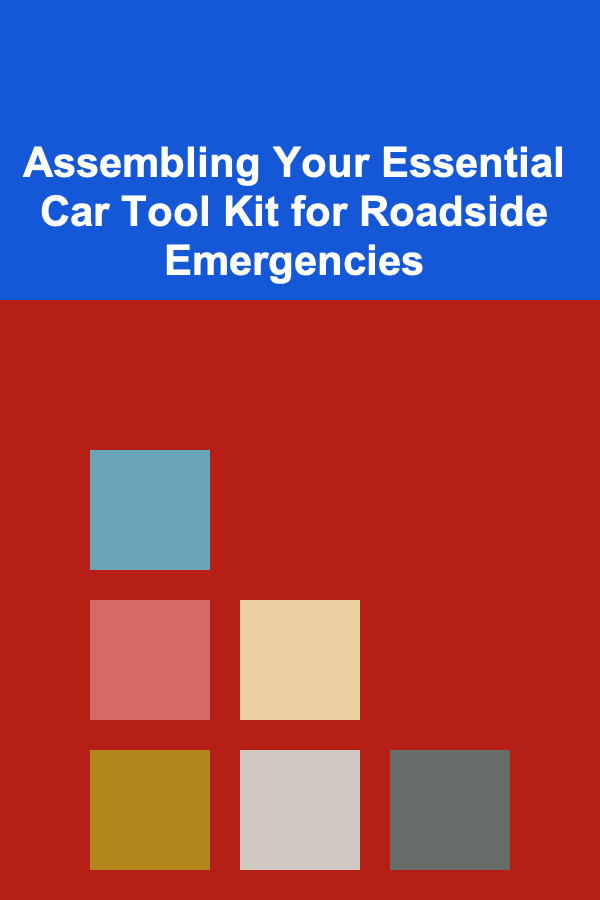
Assembling Your Essential Car Tool Kit for Roadside Emergencies
ebook include PDF & Audio bundle (Micro Guide)
$12.99$5.99
Limited Time Offer! Order within the next:

Breaking down on the side of the road is a situation nobody wants to face. It's inconvenient, stressful, and can even be dangerous, especially in inclement weather or high-traffic areas. While we can't completely eliminate the possibility of mechanical issues, we can significantly improve our ability to handle them by preparing a comprehensive car tool kit. A well-stocked emergency kit empowers you to perform basic repairs, address minor issues, and signal for help effectively, potentially saving you time, money, and a whole lot of frustration. This article delves deep into the essential components of a roadside emergency kit, providing a detailed guide to selecting the right tools, understanding their purpose, and maintaining your kit for optimal readiness.
Why a Roadside Emergency Kit is Crucial
Imagine this: you're miles from civilization, the sun is setting, and your car suddenly sputters and dies. Your phone battery is low, and the nearest town is a significant walk away. In this scenario, a well-prepared emergency kit can be a lifesaver. It allows you to:
- Perform Basic Repairs: Address common issues like a flat tire, a loose battery connection, or a minor hose leak.
- Signal for Help: Use flares or reflective triangles to alert other drivers to your presence and the hazard you pose.
- Stay Comfortable: Having a blanket, water, and snacks can significantly improve your comfort while waiting for assistance.
- Provide First Aid: A first-aid kit is essential for treating minor injuries.
- Reduce Stress and Anxiety: Knowing you're prepared can ease the panic that often accompanies roadside emergencies.
Beyond these immediate benefits, a roadside emergency kit promotes self-reliance and a sense of control. It transforms you from a helpless victim into a proactive problem-solver. It's not just about the tools; it's about the peace of mind that comes with knowing you're equipped to handle unexpected challenges.
Core Components of Your Emergency Kit
Let's break down the essential items that should be included in every roadside emergency kit:
1. Tire Changing Tools
A flat tire is perhaps the most common roadside emergency. Having the right tools to change it is paramount. Here's what you need:
- Spare Tire (Inflated): This seems obvious, but regularly check the inflation of your spare tire. An under-inflated spare is as useless as no spare at all.
- Jack: Ensure your jack is in good working order and rated for the weight of your vehicle. Practice using it at home before you need it on the road. Familiarize yourself with the jacking points on your car's frame (refer to your owner's manual). Consider investing in a hydraulic bottle jack for easier lifting, especially for heavier vehicles.
- Lug Wrench: A lug wrench is used to loosen and tighten the lug nuts that secure the wheel. The lug wrench that comes with your car is often inadequate. A four-way lug wrench (also known as a "spider" wrench) provides more leverage and is generally easier to use. Consider a telescoping lug wrench for even greater leverage. Make sure the lug wrench size matches your vehicle's lug nut size.
- Wheel Chocks: These are crucial for preventing your vehicle from rolling while you're changing a tire. Place them behind the wheels that are opposite the tire you're changing.
Advanced Tip: A lug nut socket set can be a valuable addition, especially if your lug nuts are corroded or unusually tight. Also, consider a breaker bar for extra leverage when loosening stubborn lug nuts. A piece of wood or a sturdy rock can also be used as a makeshift wheel chock if necessary.
2. Jumper Cables
A dead battery is another frequent cause of roadside breakdowns. Jumper cables allow you to jump-start your car using another vehicle's battery.
- Heavy-Duty Jumper Cables: Invest in high-quality jumper cables with thick gauge wires (4-gauge or thicker is recommended). Thinner cables may not be able to deliver enough current to start your car. Look for cables with insulated clamps and a sufficient length (at least 12 feet) to reach between vehicles parked in various orientations. Read the gauge printed on the cable itself - do not rely solely on packaging.
Safety First: Always follow the proper procedure for jump-starting a car to avoid damaging either vehicle's electrical system or causing injury. Refer to your owner's manual or a reliable online resource for detailed instructions. Consider a portable jump starter as an alternative - these self-contained units eliminate the need for a second vehicle.
3. Basic Hand Tools
A small selection of basic hand tools can be invaluable for addressing a wide range of minor repairs.
- Adjustable Wrench: A versatile tool for loosening and tightening nuts and bolts of various sizes.
- Pliers (Needle-Nose and Regular): Useful for gripping, bending, cutting, and reaching into tight spaces.
- Screwdrivers (Phillips and Flathead): Essential for tightening and loosening screws. Consider a multi-bit screwdriver for added versatility.
- Duct Tape: A universal fix-it tool for temporary repairs.
- Utility Knife: Useful for cutting hoses, removing debris, or performing other tasks.
- Multi-tool: a Leatherman or similar multi-tool can offer a plethora of functions in a compact package.
- Zip Ties: Useful for securing loose parts or temporarily holding things together.
Organization is Key: Keep your hand tools organized in a toolbox or tool roll to prevent them from getting lost or damaged. A small set of metric and SAE wrenches and sockets can be beneficial, but only if you know how to use them and your car requires them. Otherwise, stick to the essentials to save space and weight.
4. Safety and Visibility Equipment
Being visible to other drivers is crucial for your safety and the safety of others when you're stranded on the side of the road.
- Reflective Warning Triangles: Place these behind your vehicle to warn oncoming traffic. Deploy them at a distance of 100 feet or more, depending on the speed limit.
- Flares (or LED Flares): Flares provide a bright, visual warning, especially at night. LED flares are a safer, reusable alternative to traditional pyrotechnic flares. Follow local regulations regarding the use of flares.
- High-Visibility Vest: Wear a bright, reflective vest to make yourself more visible to other drivers, especially in low-light conditions.
- Flashlight (with Extra Batteries): A flashlight is essential for working on your car at night or in dark conditions. A headlamp is even better, as it allows you to keep both hands free. Consider a flashlight with a strobe function for signaling for help. LED flashlights are more energy-efficient and durable than traditional incandescent flashlights.
Placement Matters: Store your safety equipment in an easily accessible location, such as your trunk or passenger compartment. Practice deploying your reflective triangles and flares before you need them in an emergency.
5. First-Aid Kit
A well-stocked first-aid kit is essential for treating minor injuries that may occur during a roadside emergency.
- Bandages (Various Sizes): For covering cuts and scrapes.
- Antiseptic Wipes: For cleaning wounds.
- Gauze Pads: For dressing wounds and absorbing blood.
- Medical Tape: For securing bandages.
- Pain Relievers (Ibuprofen or Acetaminophen): For relieving pain.
- Antihistamine: For treating allergic reactions.
- Scissors: For cutting bandages or clothing.
- Tweezers: For removing splinters or debris.
- CPR Mask: For providing rescue breaths.
- First-Aid Guide: A basic guide to administering first aid.
Regularly Inspect Your Kit: Check your first-aid kit periodically to ensure that the supplies are not expired and that any used items are replaced. Consider taking a basic first-aid and CPR course to learn how to use the supplies in your kit effectively.
6. Fluids and Lubricants
Having a small supply of essential fluids and lubricants can help you address minor fluid leaks or top off low levels.
- Motor Oil: The correct grade for your vehicle (check your owner's manual). A quart or two can be a lifesaver if your engine is burning oil.
- Coolant (Antifreeze): A 50/50 mixture of coolant and water. For topping off the radiator in case of a leak.
- Brake Fluid: The correct type for your vehicle (check your owner's manual). For topping off the brake fluid reservoir.
- WD-40 or Penetrating Oil: For loosening rusted bolts and nuts.
Prevention is Best: Regularly check your vehicle's fluid levels and address any leaks promptly to prevent them from becoming major problems. Store fluids in tightly sealed containers to prevent leaks and spills.
7. Comfort and Survival Items
If you're stranded for an extended period, having some basic comfort and survival items can make a big difference.
- Blanket: For warmth in cold weather. A space blanket is a compact and lightweight option.
- Water: At least one gallon of water per person. Dehydration can set in quickly, especially in hot weather.
- Non-Perishable Food: Energy bars, nuts, dried fruit, or other non-perishable snacks.
- Cell Phone Charger (Car Adapter): To keep your phone charged. A portable power bank is also a good idea.
- Whistle: For signaling for help.
- Duct tape: For a multitude of uses
- Rain Poncho: To stay dry in rainy weather
- Work Gloves: To protect your hands while working on your car
- Paper Towels or Rags: For cleaning up spills and wiping your hands.
- Small Shovel (Folding): For digging out of snow or mud.
Seasonal Considerations: Adjust your comfort and survival items based on the season. In winter, include warm clothing, a hat, and gloves. In summer, include sunscreen and insect repellent.
Selecting the Right Tools and Equipment
Choosing the right tools and equipment for your emergency kit is crucial for ensuring its effectiveness. Here are some factors to consider:
- Quality: Invest in high-quality tools that are durable and reliable. Cheap tools may break or fail when you need them most.
- Size and Weight: Choose tools that are compact and lightweight to save space and weight in your vehicle.
- Ease of Use: Select tools that you are comfortable using and familiar with. Practice using them at home before you need them on the road.
- Vehicle Compatibility: Ensure that the tools you choose are compatible with your vehicle's make and model. For example, the lug wrench must be the correct size for your lug nuts.
- Your Mechanical Skills: Don't include tools that you don't know how to use. Focus on the basics and gradually expand your kit as your skills improve.
- Budget: You don't need to spend a fortune to assemble a good emergency kit. Start with the essentials and gradually add more items as your budget allows.
Brand Recommendations: While personal preferences vary, some reputable brands for automotive tools include Craftsman, Stanley, Gearwrench, and Dewalt. For jumper cables, look for brands like Schumacher or TOPDC. For flashlights, consider brands like Streamlight or Maglite.
Organizing and Storing Your Emergency Kit
Proper organization and storage are essential for keeping your emergency kit readily accessible and in good condition.
- Container: Choose a sturdy and waterproof container, such as a plastic tote or a tool bag. Make sure the container is large enough to hold all of your supplies without being too bulky.
- Organization: Use dividers or compartments to keep your tools and supplies organized. Label the compartments so you can easily find what you need.
- Accessibility: Store your emergency kit in an easily accessible location, such as your trunk or passenger compartment. Avoid storing it under heavy items that may be difficult to move in an emergency.
- Security: Secure your emergency kit to prevent it from sliding around in your vehicle, especially during sudden stops.
Placement Tips: The ideal location for your emergency kit depends on your vehicle's layout. Some popular options include: the trunk, under the seats, or in a cargo organizer. Make sure that everyone who drives the vehicle knows where the kit is located.
Maintaining Your Emergency Kit
Regular maintenance is crucial for ensuring that your emergency kit is ready to use when you need it.
- Inspection: Inspect your emergency kit at least twice a year, or more frequently if you live in a harsh climate.
- Battery Check: Check the batteries in your flashlight and replace them if necessary.
- Fluid Levels: Check the fluid levels in your motor oil, coolant, and brake fluid containers. Replace any fluids that have leaked or evaporated.
- Expiration Dates: Check the expiration dates on your first-aid supplies and replace any expired items.
- Tool Condition: Inspect your tools for rust, corrosion, or damage. Clean and lubricate them as needed.
- Spare Tire Pressure: Check the pressure of your spare tire and inflate it to the recommended pressure.
Proactive Replacement: Replace any damaged or worn-out items immediately. Consider replacing your jumper cables every few years, as the insulation can degrade over time. Replace pyrotechnic flares every few years, as they can lose their effectiveness. Replace fluids if they show signs of contamination (e.g., discoloration or sediment).
Beyond the Basics: Advanced Additions
Once you've assembled a basic emergency kit, you can consider adding some advanced items to further enhance your preparedness.
- OBD-II Scanner: An OBD-II scanner allows you to read diagnostic trouble codes from your vehicle's computer, which can help you identify the cause of a problem.
- Digital Multimeter: A multimeter can be used to test electrical circuits and components, such as the battery, alternator, and fuses.
- Tire Repair Kit (Plug Kit): A tire repair kit allows you to temporarily repair punctures in your tires without removing the wheel. However, only use this for punctures on the tread area and never on the sidewall. After using a plug kit, get the tire professionally inspected and repaired or replaced as soon as possible.
- Portable Air Compressor: A portable air compressor can be used to inflate tires or other inflatable items.
- Mechanic's Gloves: Heavy-duty gloves that provide better protection than standard work gloves.
- Knee Pads: For protecting your knees while working on your car.
- Fire Extinguisher (Small): A small ABC fire extinguisher can be used to put out small fires in your vehicle.
- Owner's Manual: Keep a copy of your vehicle's owner's manual in your emergency kit. It contains valuable information about your vehicle's systems and how to perform basic maintenance.
- Roadside Assistance Information: Include your roadside assistance provider's phone number and membership information.
Tailor to Your Needs: The advanced items you choose will depend on your vehicle, your driving habits, and your level of mechanical expertise. Carefully consider your needs and choose items that will be most useful to you.
The Importance of Knowledge and Skills
Having the right tools is only half the battle. It's equally important to have the knowledge and skills to use them effectively.
- Learn Basic Car Maintenance: Take a class or watch online videos to learn how to perform basic car maintenance tasks, such as changing a tire, jump-starting a car, checking fluid levels, and replacing fuses.
- Practice: Practice using your emergency tools and equipment at home before you need them on the road. This will help you become more familiar with them and build your confidence.
- Read Your Owner's Manual: Your owner's manual contains valuable information about your vehicle's systems and how to perform basic maintenance.
- Stay Informed: Keep up-to-date on the latest car maintenance tips and techniques.
- Know Your Limits: Don't attempt repairs that are beyond your capabilities. If you're not comfortable performing a particular task, call for professional assistance.
Safety First: Always prioritize safety when working on your car. Wear safety glasses, gloves, and other protective gear. Work in a well-ventilated area. Never work under a vehicle that is only supported by a jack. Use jack stands to support the vehicle's weight.
Conclusion: Preparedness is Key
Assembling a comprehensive car tool kit for roadside emergencies is an investment in your safety, your peace of mind, and your ability to handle unexpected challenges on the road. By equipping yourself with the right tools, knowledge, and skills, you can transform a potentially stressful and dangerous situation into a manageable one. Remember, preparedness is not just about having the tools; it's about the confidence that comes from knowing you're ready for anything the road may throw your way. Regularly inspect and maintain your kit, practice using the tools, and continue to learn about car maintenance. A little preparation can go a long way in ensuring your safety and well-being on the road.

How to Create a Sustainable Budget with a Variable Income
Read More
How to Create an Effective Job Search Plan
Read More
How to Plan a Budget-Friendly Home Renovation
Read More
Why Creating Zones in Your Home Enhances Flow
Read More
How To Master Economy and Itemization in MOBAs
Read More
How to Build a Crisis-Resistant Portfolio
Read MoreOther Products

How to Create a Sustainable Budget with a Variable Income
Read More
How to Create an Effective Job Search Plan
Read More
How to Plan a Budget-Friendly Home Renovation
Read More
Why Creating Zones in Your Home Enhances Flow
Read More
How To Master Economy and Itemization in MOBAs
Read More